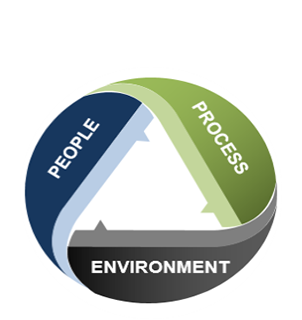Our Approach
Our Philosophy
Innovation management requires assessing the organization from several angles. Many corporate innovation leaders we find are seeking out the next tool or software solution but will it have the effect on innovation results that they want? For most organizational leaders looking to improve their innovation results, focusing on process alone is likely to be the least effective. Why is this the least likely place to start to improve innovation management? Because people run processes. Great innovation management requires the right people, this factor is the most critical to improve results. Next, is that within the organization innovation management and leaders foster the right culture (and environment). Thus, when you are seeking to improve innovation results, the process and tools that are implemented should be done within this context of ensuring the right people and right environment are in place.

This is why The Valen Group utilize a holistic approach to improving results. Our innovation assessment focuses on three areas of innovation management:
Innovation is doing new things that create value for the organization. In many cases, innovation is hard because to do new things we must create something. Creation or discovery, when observing, might look quite random at times and can be serendipitous in many cases. Doing something new also means that change is involved which is uncomfortable for a profitable, large organization with structure that has provided significant returns and value in the past. Innovation management should look for team members who are open to new ideas and environments. These are the innovators who find insight and leverage stimulus that helps them think in new ways. It is because of the openness of our team members, and the freedom given by innovation management who sponsor these efforts, that an organization is more likely to result in breakthrough innovation solution. Openness is one of the factors that we consider when assessing team members. Another factor is flexibility, because the problem-solving skills necessary to generate ideas are different from the skills to assess the feasibility or value of a concept, solution or new business model. It is important that your consulting firm partner has methods to manage and assess these skills so you get the best results from your innovation teams. We have an innovation management solution to assess each team member’s problem-solving thinking style that helps them learn their preferred methods and how to recognize the various methods needed as we go from concept to execution, vastly improving team results.
Innovation Management of New Business Models is extremely difficult for Corporations
Success in innovation management in large organizations, such as sponsoring a team that creates a rare, new business model, is very difficult for corporate leaders to...
Innovation Management of New Business Models is extremely difficult for Corporations
Success in innovation management in large organizations, such as sponsoring a team that creates a rare, new business model, is very difficult for corporate leaders to...
“stay the course” because it requires patience and a willingness to spend time and money to learn with little immediate return. This is why entrepreneurs and venture capitalists have an edge because new business models are more likely to fail than succeed and must be managed financially from a portfolio approach where concepts or models should be taken to market quickly and managed to fail fast.
Innovation process is critical to allow for the evolution of a concept. A good process doesn’t allow leaders to skip steps. Many times, the first idea is just that; a starting point. Falling in love with a certain strategy, concept, business model or innovation solution creates bias and many times the process while well designed with check-ins or gates from senior management, only creates what we call left to right inertia (think stage gate.) The innovation process approach we see the most have basically three steps which are to 1). identify the solution, 2). develop it and 3). execute it. The processes are similar to basic flow of stages such as: Concept, Development and Go-to-Market. There can be additional steps before Go-to-Market such as Validation but that is really just finalizing developing or creating the solution. However, by making concept or solution development a step, it limits the ability to iterate and promotes the idea that a solution or innovation itself is an event not a continual improvement and refinement of a concept. Top innovation consulting firms are always creating the solution, and iterating not focusing on siloed steps that puts pressure on moving from concept to market. Similarly, you can view our approach to innovation which is called Collaborative Innovation where “create” is not a step but a continual iteration throughout the process.
The right environment is really about the right culture, decision-making authority, incentives and more. Too many times the culture is about deferring to the top leader overseeing innovation efforts. A typical stage-gate or gated process is designed for top executives to check-in and decide if the concept is ready to move to the next step, such as moving to the prototyping stage prior to the development. However, this linear thinking approach we have covered in process shortcoming, but it is also that it props up a leader and many times that leader feels forced to decide, leaving teams to defer to leaders in likely gray area decisions where the correct answer isn’t to rush to market but test multiple models or solutions using methods like lean startup that promote iteration in creation of solutions and continual learning. Innovation management environments that foster this type of iteration and learning are found within the more successful companies.
Assess Innovation Teams on Management of a project -- not the result
The best methods for innovation management require leaders to have discipline in how the assess teams. Judging teams on how they manage innovation is about managing a project or concept to a conclusion quickly and adjusting or killing it...
Assess Innovation Teams on Management of a project -- not the result
The best methods for innovation management require leaders to have discipline in how the assess teams. Judging teams on how they manage innovation is about managing a project or concept to a conclusion quickly and adjusting or killing it...
Many times, the best project leaders are managing to a quick failure by focusing on killer issues. Why manage to failure? Because much of the innovation as hypothesized doesn’t work and knowing that allows a team to “move on,” not wasting resources on a “pet” idea. “Moving on” could mean iterating or starting on the next concept or solution that is hypothesized to have major growth potential. This innovation management discipline requires the right incentives, decision-making authority and discipline. Managers must refrain from a natural “success” bias thinking that the team that found the valuable innovation are more valuable to the organization than the team members who quickly honed-in on the critical facts to find out that the innovation was not possible. Maybe the team that found the innovation spent too much time or could have done it more cost effectively? By looking at how projects were managed and how team members worked toward fast learning is a much more reliable method to evaluate innovation teams.
If you compare the venture capital industry, you will find many of the entrepreneurs who have managed a startup to a successful exit, had several failures before. These portfolio managers know that experience in failure actually helps these entrepreneurs better navigate the high uncertainly but almost certain changes and flexibility to iterate into a valuable business model; luck may well be the highest correlation to an early career success versus skill or repeatability. Those who want repeatable success in managing innovation teams should consider what innovation management system is in place to assess and reward their teams.
What We Do
Innovation Strategy Assessment
This is focused on innovation direction and communication where we assess the understanding, clarity and linkage to growth strategy, how innovation strategy fits within growth strategy, and where growth is coming from. It leverages growth and financial results due to innovation and historical projects across the corporation, division or target group.
As part of this assessment we typically explore critical activities and results from innovation as defined:
Innovation Environment
Which is heavily influenced by management behavior and culture. We assess what types of projects are prioritized, promoted, funded and especially how failure or learning is viewed in context of business risk and risk management.
Innovation Thinking-Styles
Which assess how members of innovation teams approach problems, how they perceive others and assess best practices across the core elements of the innovation process.
Innovation Process
Which assess the innovation process, interaction, collaboration, and hand-offs. It includes the type of innovation such as portfolio formation, prioritization and management, and other aspects to improve speed, effectiveness and allocation of resources to better results.
Innovation Management Services
- Benchmark Studies of your innovation practices against best practices and provide a recommendation for areas of improvement in innovation
- Innovation Strategy approach to define and separate types of innovation and provide methodology to build a multi-year roadmap for innovation team direction
- Innovation Consulting services on organizational structure and management practices to improve clarity of ROI, alignment to vision and strategy and ability to produce well defined results
- Innovation Metrics development or enhancement to deliver a cohesive set of a few key performance metrics through our innovation metric development methodology
Example of Innovation Management Engagement Experience
- Assessed the innovativeness of a major healthcare instruments company whose teams were not as effective as they could be; identified lack of ideation thinking styles and limited climate of trust due to project team formation, multi-department oversight; recommended people and team on-boarding changes that improved team morale and effectiveness.
- Developed an innovation process that reduced the development cycle by 40% by setting strategy and defining platforms for development.
- Trained senior management on the linkage between strategy and innovation (technology and application of technology, NPD) in driving competitive advantage and financial results.
- Global benchmarking study to recommend a global coordination model for innovation linking decisions from core technology, application of technology to regional/local market customization.
- Defined a venture development process to incubate new businesses and business models to expand the boundaries of the organize and helped them manage higher risk growth projects separate from core business.
- Integrated into the innovation approach best practice design thinking with lean startup methods to leverage behavioral insight methods in a flexible framework to improve probability of success in front-end innovation.
- Innovation metrics development for a major food & beverage company who was reorganizing their R&D packaging technologies, etc. into innovation groups.
















